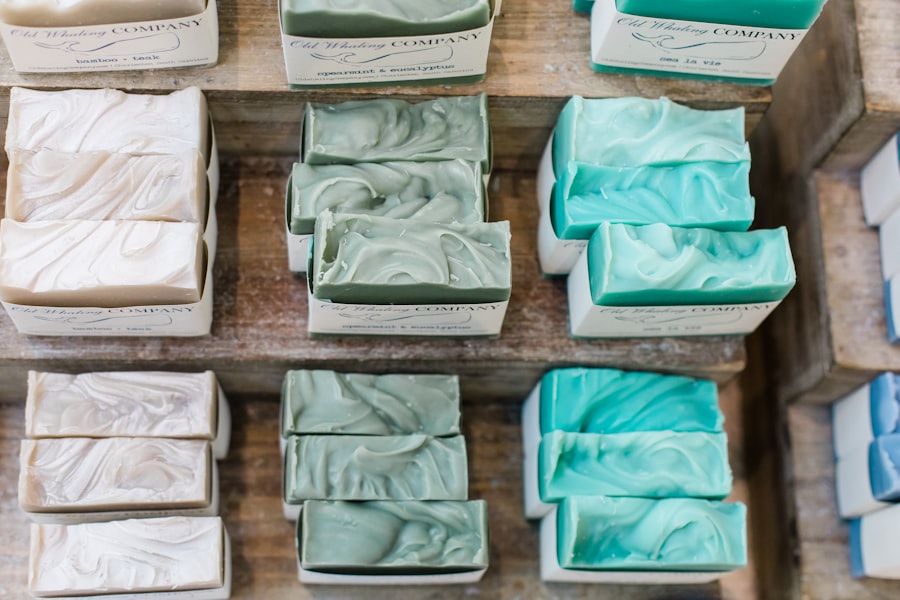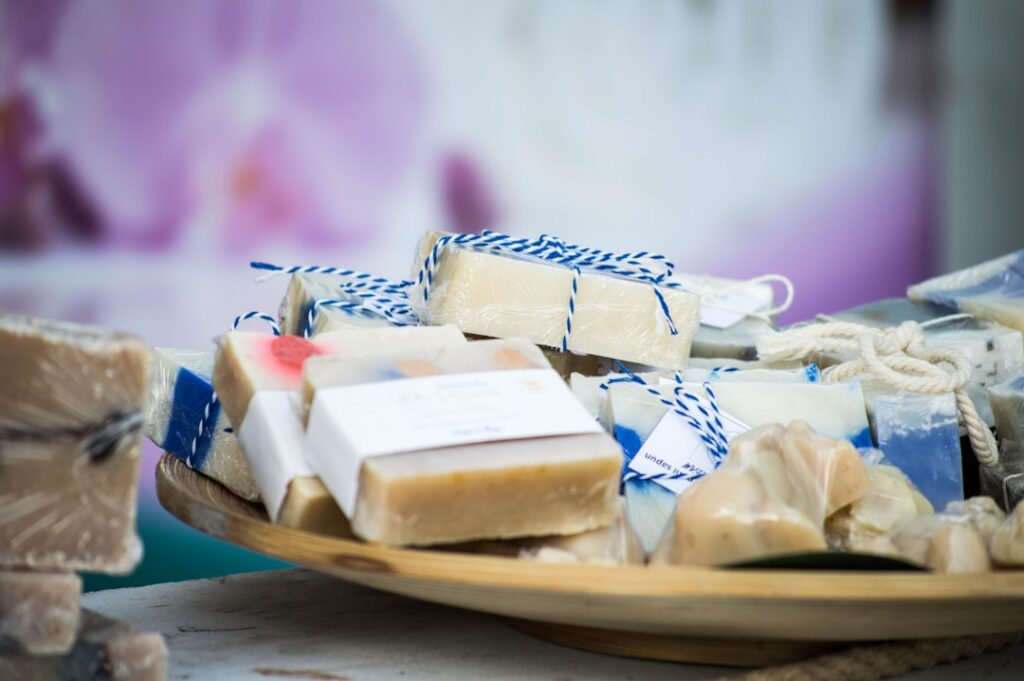Soap making is an ancient craft that dates back thousands of years. The earliest evidence of soap making can be traced back to ancient Babylon, where a clay tablet was discovered with a recipe for soap written on it. Throughout history, soap has been used for personal hygiene, cleaning, and even as a form of currency.
Making your own soap has become increasingly popular in recent years, as people are becoming more conscious of the ingredients in their skincare products. By making your own soap, you have complete control over the ingredients used, ensuring that you are using only natural and nourishing substances on your skin.
Soap making is also a great hobby for beginners because it is relatively easy to learn and requires minimal equipment. It allows you to tap into your creativity and create unique and personalized soaps that are tailored to your skin type and preferences. Whether you prefer a moisturizing bar with a delicate scent or an exfoliating soap with vibrant colors, the possibilities are endless when it comes to soap making.
Key Takeaways
- Soap making is a beginner-friendly hobby that can be done at home with the right tools and ingredients.
- Making your own soap allows you to control the ingredients and avoid harsh chemicals found in commercial soaps.
- When choosing a soap making kit, consider the type of soap you want to make and the tools included in the kit.
- Essential tools for soap making include a scale, thermometer, and molds, while ingredients include oils, lye, and water.
- Follow a step-by-step guide to make your first batch of soap, and customize your recipe with fragrance and color.
The Benefits of Making Your Own Soap
One of the main benefits of making your own soap is the control you have over the ingredients used. Many commercial soaps contain harsh chemicals and synthetic fragrances that can irritate the skin. By making your own soap, you can choose natural and nourishing ingredients that are gentle on the skin. You can also customize your soap to suit your specific skin type and preferences, whether you have dry skin that needs extra moisture or oily skin that requires balancing.
Another benefit of making your own soap is that it is cost-effective. While the initial investment in equipment and ingredients may seem high, once you have everything you need, you can make multiple batches of soap at a fraction of the cost of store-bought options. This is especially true if you buy ingredients in bulk or grow your own herbs and botanicals to use in your soaps.
In addition to being cost-effective, making your own soap is also environmentally friendly. Many commercial soaps come packaged in plastic containers that end up in landfills. By making your own soap, you can reduce waste by using reusable molds and packaging your soap in eco-friendly materials. You can also choose to use natural and organic ingredients that are better for the environment and your skin.
Choosing the Right Soap Making Kit for Beginners
When it comes to choosing a soap making kit for beginners, there are several options available. The most common types of soap making kits include melt and pour kits, cold process kits, and hot process kits.
Melt and pour kits are the easiest option for beginners, as they involve melting pre-made soap bases and adding your own fragrance and color. This method does not require any lye or curing time, making it a great option for those who want instant gratification.
Cold process kits involve mixing oils and lye to create soap from scratch. This method requires more time and patience, as the soap needs to cure for several weeks before it is ready to use. However, it allows for more customization and creativity, as you can choose your own oils, fragrances, and colors.
Hot process kits are similar to cold process kits, but they involve cooking the soap mixture in a crockpot or slow cooker. This method speeds up the curing time, allowing you to use the soap sooner. It also gives the soap a rustic and textured appearance.
When choosing a soap making kit for beginners, there are several factors to consider. First, consider your skill level and comfort with handling lye. If you are new to soap making or prefer a safer option, a melt and pour kit may be the best choice. If you are comfortable working with lye and want more control over the ingredients used, a cold process or hot process kit may be a better fit.
It is also important to consider the size of the kit and the number of bars of soap it will produce. Some kits may only make a few bars of soap, while others may make several pounds. Consider how much soap you want to make and how much space you have for curing and storing the soap.
Recommended kits for beginners include the Soap Making Starter Kit by Bramble Berry, the Melt and Pour Soap Making Kit by CraftZee, and the Cold Process Soap Making Kit by Pure & Gentle Soap. These kits come with all the necessary ingredients and instructions to get started, making them perfect for beginners.
Essential Tools and Ingredients for Soap Making
| Tool/Ingredient | Description |
|---|---|
| Lye | An essential ingredient in soap making that reacts with oils to create soap. |
| Oil/Fat | The main ingredient in soap making that reacts with lye to create soap. |
| Scale | A tool used to accurately measure ingredients for soap making. |
| Thermometer | A tool used to monitor the temperature of the lye and oils during the soap making process. |
| Mold | A container used to shape and hold the soap during the curing process. |
| Essential Oils/Fragrance Oils | Ingredients used to add scent to the soap. |
| Colorants | Ingredients used to add color to the soap. |
| Distilled Water | Water that has been purified and is used in soap making to dissolve the lye. |
| Gloves and Safety Gear | Protective gear worn during the soap making process to prevent burns and other injuries. |
Before you can start making soap, you will need to gather a few essential tools. While there are many specialized tools available for soap making, you can also use common kitchen items to get started.
The basic tools needed for soap making include a heat-resistant container (such as a stainless steel or glass bowl), a digital scale for measuring ingredients, a stick blender for mixing the soap, a thermometer for monitoring temperatures, a silicone spatula for scraping the sides of the container, and molds for shaping the soap.
In addition to these basic tools, you will also need a few essential ingredients. The main ingredient in soap is a combination of oils or fats. Common oils used in soap making include olive oil, coconut oil, palm oil, and castor oil. Each oil has different properties that contribute to the final product, such as hardness, lather, and moisturizing properties.
You will also need lye, which is a caustic substance that is necessary for saponification (the chemical reaction that turns oils into soap). It is important to handle lye with caution and follow safety guidelines when working with it.
Other ingredients you may want to include in your soap recipes include fragrances (such as essential oils or fragrance oils), colorants (such as natural clays or mica powders), exfoliants (such as ground coffee or oatmeal), and moisturizers (such as shea butter or cocoa butter).
You can purchase soap making tools and ingredients from various online retailers, such as Bramble Berry, Wholesale Supplies Plus, and Amazon. You can also find some ingredients at local craft stores or health food stores.
Step-by-Step Guide to Making Your First Batch of Soap
Now that you have gathered your tools and ingredients, it’s time to start making soap! Before you begin, it is important to take some safety precautions to ensure a safe and successful soap making experience.
First, make sure you are working in a well-ventilated area. Lye fumes can be harmful if inhaled, so it is important to have proper ventilation. You may want to open a window or use a fan to circulate the air.
Next, make sure you are wearing protective gear, such as gloves and goggles. Lye is caustic and can cause burns if it comes into contact with your skin or eyes. It is important to protect yourself by wearing the appropriate gear.
Once you have taken these safety precautions, you can begin making soap. The following is a step-by-step guide for making your first batch of soap using the cold process method:
1. Prepare your workspace by covering it with newspaper or plastic wrap to protect it from any spills or messes.
2. Weigh out your oils and fats using a digital scale. You will need to calculate the amount of lye needed based on the weight of your oils. There are online calculators available that can help you determine the correct amount of lye for your recipe.
3. In a heat-resistant container, carefully measure out the lye using a digital scale. Slowly add the lye to distilled water (never add water to lye) while stirring gently with a heat-resistant spoon or spatula. Be careful not to inhale the fumes or let the mixture come into contact with your skin.
4. Allow the lye mixture to cool to around 100-110°F (38-43°C). Meanwhile, melt your oils and fats in a separate heat-resistant container until they are fully liquid.
5. Once both the lye mixture and oils are at the correct temperature, slowly pour the lye mixture into the oils while stirring gently with a stick blender. Continue blending until the mixture reaches trace, which is when it thickens to a pudding-like consistency.
6. Add any fragrance, colorants, exfoliants, or moisturizers to the soap mixture and blend until fully incorporated.
7. Pour the soap mixture into your molds and tap them gently on the counter to remove any air bubbles. You can also swirl the soap with a skewer or toothpick to create unique designs.
8. Cover the molds with a piece of cardboard or plastic wrap to insulate them and prevent soda ash (a harmless white powder that can form on the surface of soap) from forming.
9. Allow the soap to cure for 24-48 hours before unmolding. Once unmolded, cut the soap into bars and place them on a drying rack or tray.
10. Allow the soap to cure for 4-6 weeks in a cool, dry place before using. This allows time for the soap to harden and for any excess moisture to evaporate.
Tips for Customizing Your Soap Recipes

One of the great things about making your own soap is that you can customize it to suit your preferences and needs. Here are some tips for customizing your soap recipes:
1. Adding exfoliants and moisturizers: If you want to add some extra benefits to your soap, consider adding exfoliants or moisturizers. Exfoliants such as ground coffee, oatmeal, or poppy seeds can help remove dead skin cells and leave your skin feeling smooth and refreshed. Moisturizers such as shea butter, cocoa butter, or avocado oil can help hydrate and nourish the skin.
2. Using different oils and butters: Different oils and butters have different properties that can affect the final product. For example, coconut oil creates a hard bar with a fluffy lather, while olive oil creates a softer bar with a creamy lather. Experiment with different combinations of oils and butters to find the perfect recipe for your skin type.
3. Creating unique designs and shapes: Soap making is not just about creating a functional product; it is also an opportunity to get creative and have fun. You can create unique designs and shapes by using different molds, layering different colors, or swirling the soap with a skewer or toothpick. The possibilities are endless when it comes to creating beautiful and artistic soaps.
Adding Fragrance and Color to Your Soap
Adding fragrance and color to your soap can enhance the sensory experience and make your soap more appealing. There are several options available when it comes to adding fragrance and color to your soap.
When it comes to fragrance, you can choose between essential oils or fragrance oils. Essential oils are derived from plants and offer natural scents that can be soothing and therapeutic. Fragrance oils, on the other hand, are synthetic scents that come in a wide variety of options. Both options have their pros and cons, so it is important to choose the one that suits your preferences.
To incorporate fragrance into your soap, you will need to add it during the mixing process. Once your soap mixture has reached trace, you can add the fragrance oil or essential oil and blend it in thoroughly. Keep in mind that some fragrances may accelerate trace or cause discoloration, so it is important to do some research before choosing a fragrance.
When it comes to adding color to your soap, there are several options available. Natural colorants such as clays, herbs, and spices can be used to create earthy and muted tones. Mica powders and liquid colorants offer a wide range of vibrant and bold colors. You can also experiment with layering different colors or creating swirls for a more artistic effect.
To incorporate color into your soap, you will need to add it during the mixing process. Once your soap mixture has reached trace, you can add the colorant and blend it in thoroughly. Keep in mind that some colorants may morph or fade over time, so it is important to do some research before choosing a color.
It is important to note that fragrance and color can affect the performance of your soap. Some fragrances may cause the soap to accelerate trace or seize, making it difficult to work with. Some colorants may bleed or stain, affecting the appearance of the soap. It is important to test your fragrances and colorants before using them in a large batch of soap.
Common Soap Making Mistakes and How to Avoid Them
As with any craft, there are common mistakes that beginners may make when first starting out with soap making. Here are some common soap making mistakes and how to avoid them:
1. Not measuring ingredients accurately: Soap making is a precise science that requires accurate measurements. It is important to use a digital scale to weigh out your ingredients and follow the recipe closely. Even small variations in measurements can affect the final outcome of your soap.
2. Not following safety precautions: Soap making involves working with caustic substances such as lye, so it is important to follow safety precautions to protect yourself. Always wear protective gear such as gloves and goggles, work in a well-ventilated area, and handle lye with caution.
3. Overheating or underheating the soap: Soap making requires precise temperatures for the lye and oils. If the lye mixture is too hot or too cold, it may not properly saponify the oils. If the oils are too hot or too cold, they may not mix properly with the lye. It is important to monitor temperatures closely and adjust as needed.
4. Not blending the soap mixture thoroughly: Properly blending the soap mixture is crucial for achieving a smooth and uniform texture. It is important to blend the mixture until it reaches trace, which is when it thickens to a pudding-like consistency. If the mixture is not blended enough, it may separate or have uneven textures.
5. Adding fragrance or color at the wrong time: Adding fragrance or color at the wrong time can affect the performance and appearance of your soap. Fragrances should be added after the soap mixture has reached trace, while colorants should be added at the same time as the fragrance. Adding them too early or too late can result in uneven distribution or discoloration.
If you do make a mistake while making soap, don’t panic! Many mistakes can be fixed or salvaged with a little creativity and problem-solving. For example, if your soap seizes or accelerates trace, you can try adding more liquid or using a stick blender to blend it back to a smooth consistency. If your soap turns out softer than desired, you can allow it to cure for longer to harden.
The key to avoiding mistakes in the future is practice and experience. The more you make soap, the more you will become familiar with the process and develop a better understanding of the ingredients and techniques involved. Through practice, you will gain a sense of what works and what doesn’t, allowing you to make adjustments and improvements along the way. Experience also plays a crucial role in avoiding mistakes as it helps you anticipate potential issues and challenges that may arise during the soap-making process. By learning from past mistakes and applying that knowledge to future batches, you can refine your skills and create high-quality soaps with confidence.

